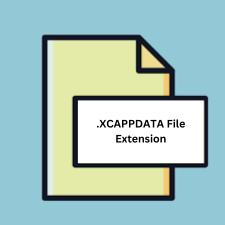.XCAPPDATA File Extension

Xcode App Data File
| Developer | Apple |
| Popularity | |
| Category | Developer Files |
| Format | .XCAPPDATA |
| Cross Platform | Update Soon |
What is an XCAPPDATA file?
.XCAPPDATA files are associated with Xcode, Apple’s integrated development environment (IDE) for macOS. These files store app data in a structured format, primarily for use during development and testing phases of iOS and macOS applications.
More Information.
The .XCAPPDATA file format was introduced to streamline the app development process in Xcode. It allows developers to maintain consistent test data across different stages of the development cycle, from debugging to final testing. The primary purpose was to provide a simple way to manage and transfer app data configurations without needing to rely on the actual app installation on a device.
Origin Of This File.
.XCAPPDATA files are created by Xcode when developers set up data containers for their applications. These containers facilitate the process of testing and debugging by allowing developers to simulate app data environments.
File Structure Technical Specification.
- Directory Structure:
- AppData: Contains the data specific to the app, including documents, settings, and other user-generated content.
- Documents: This folder mimics the app’s documents directory where user files are stored.
- Library: Includes subfolders for Caches, Preferences, and other app-specific data.
- Configuration Files:
- Metadata: Contains information about the app data container, including version and compatibility details.
- Data Files: Various files that represent the app’s data, such as SQLite databases, binary files, and plist files.
- Technical Format:
- The .XCAPPDATA package is essentially a directory bundle that Xcode reads and writes. It is not a single monolithic file but rather a structured directory that macOS recognizes as a bundle.
How to Convert the File?
Windows
- Extract Files:
- Transfer to Mac: Since .XCAPPDATA files are designed for macOS, transfer the file to a Mac system.
- Use Virtual Machine: Alternatively, use a macOS virtual machine on Windows to open and extract contents using Xcode.
- Access Contents:
- Once on a Mac system or virtual machine, open the .XCAPPDATA file with Xcode.
- Navigate to the desired data files (e.g., SQLite databases, plist files).
- Convert Files:
- SQLite: Use tools like DB Browser for SQLite on Windows.
- Plist: Convert plist files to JSON or XML using tools like plist Editor Pro or online converters.
Linux
- Mount Filesystem:
- Use HFS+ or APFS tools like
hfsprogsto mount the macOS filesystem if the .XCAPPDATA file is on a Mac-formatted disk.
- Use HFS+ or APFS tools like
- Extract Files:
- Transfer the .XCAPPDATA file to a Mac system to extract contents using Xcode.
- Access Contents:
- Use Xcode on macOS to access and export the data files.
- Convert Files:
- SQLite: Use
sqlite3command-line tools or graphical tools like DB Browser for SQLite on Linux. - Plist: Use
plistutilorplutilon Linux to convert plist files.
- SQLite: Use
macOS
- Open with Xcode:
- Right-click the .XCAPPDATA file and select “Open With” -> “Xcode”.
- Access Contents:
- Navigate to the directories within the .XCAPPDATA file (AppData, Documents, Library).
- Export and Convert:
- SQLite: Export databases and open with SQLite-compatible tools.
- Plist: Use built-in macOS tools like
plutilto convert to XML or JSON.
Android
- Transfer Files:
- Transfer the .XCAPPDATA file to a Mac system.
- Extract Contents:
- Use Xcode on macOS to extract the data.
- Access and Convert:
- SQLite: Transfer SQLite databases back to Android and use apps like aSQLiteManager.
- Plist: Convert plist files to JSON on macOS, then transfer to Android for further use.
iOS
- Transfer Files:
- Transfer the .XCAPPDATA file to a Mac system using AirDrop, iCloud, or a physical connection.
- Extract Contents:
- Use Xcode on macOS to open the file and extract contents.
- Convert Files:
- SQLite: Open databases on macOS and convert or use iOS-compatible SQLite tools.
- Plist: Convert plist files on macOS before transferring them back to iOS.
Other Systems
- Access macOS System:
- Use a Mac system directly or a virtual machine with macOS installed.
- Extract Contents:
- Open the .XCAPPDATA file with Xcode to access and export the data files.
- Convert Files:
- SQLite: Export and convert using appropriate tools compatible with your system.
- Plist: Convert plist files using macOS tools and transfer to your desired format.
Advantages And Disadvantages.
Advantages:
- Simplifies Testing: Provides a straightforward way to test app behaviors with different data sets.
- Consistency: Ensures that the test data remains consistent across different testing environments.
- Ease of Transfer: Developers can easily share app data configurations with team members.
Disadvantages:
- Platform Dependency: Primarily designed for use with Xcode on macOS, limiting its utility in other environments.
- Complexity: For new developers, the structure and management of .XCAPPDATA files can be complex.
How to Open XCAPPDATA?
Open In Windows
.XCAPPDATA files cannot be directly opened in Windows. However, you can use tools like HFSExplorer to access macOS filesystems on Windows, but functionality will be limited.
Open In Linux
Similar to Windows, .XCAPPDATA files are not natively supported. You can mount the filesystem using tools like hfsprogs to browse the directory structure.
Open In MAC
Opened natively in Xcode. Right-click on the .XCAPPDATA file in Xcode and choose “Show in Finder” to access the contents.
Open In Android
Android does not support .XCAPPDATA files. You would need to transfer the files to a macOS system for access.
Open In IOS
Direct opening on iOS devices is not supported. Use Xcode on macOS to manage these files.
Open in Others
Other systems like web-based platforms do not support .XCAPPDATA files. The primary method remains using Xcode on macOS.













